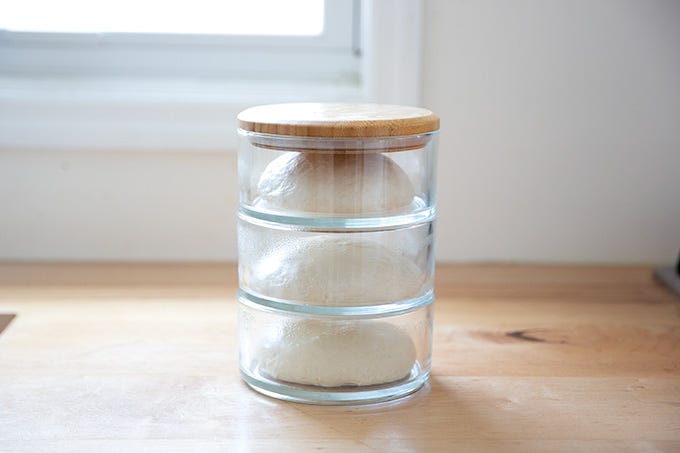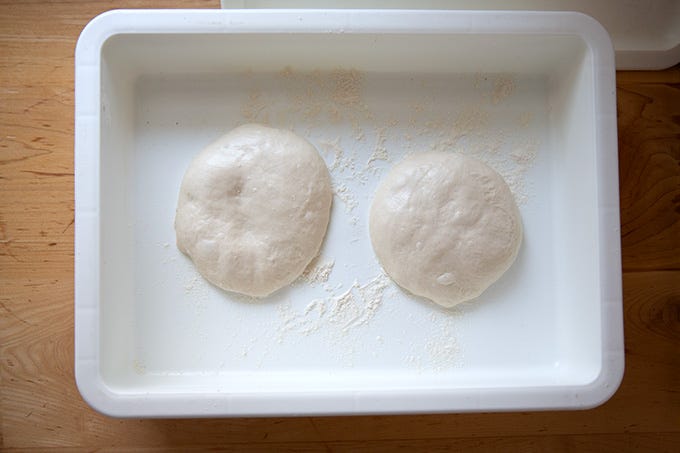Hello Pizza Friends,
Today’s post is a thrilling one: we’re talking dough storage and specifically the three types of vessels you need to ensure your dough stays happy at every phase of the pizza-making process.
Let’s back up. When I first learned to make bread and pizza, I was taught to cover bowls of rising dough with warm, damp tea towels.
For the quick-rising doughs I made for years, this method worked beautifully, the dampness of the towel allowing it to cling to the bowl, creating a sealed environment, and the slight heat of it, created a cozy one, too.
But as time went on and as new bread-making methods emerged, namely Jim Lahey’s no-knead bread, which called for an 18-hour room-temperature rise, I found the tea towel worked less effectively. After a long, slow rise, I’d remove the towel from my bowl to find my dough crusted over, a thin dried-out layer coating the mass of dough beneath.
With pizza dough, too, I found the towel ineffective even for short periods: while I let my dough balls proof on the counter under a tea towel as my oven heated up, dry spots would emerge all over the surface of my dough.
And so I found a solution: put a lid on it! Put a lid on it at every phase of the process: while the dough makes its first rise, while it proofs in the fridge, while it proofs at room temperature just before baking.
I explain in more detail and share my favorite storage vessels below. Let me know if you have any questions, and if you have a storage vessel you love, please share.
Three Vessels
You can see all of the vessels I recommend in action (as well as a preview of the pizza we’ll make next week) in this video or you can read below.
#1: The First Rise Vessel
When your dough is ready to make its first rise (also called the bulk fermentation), it should do so in a large, lidded vessel. As noted above, the lid prevents the dough from drying out, and the large size allows the dough to grow.
I love these 4-quart Pyrex bowls because they are perfect for mixing your dough, letting it rise, and storing it at room temperature or in the fridge thanks to the lid.
For sourdough, which is a little less forgiving and therefore requires closer monitoring during the bulk fermentation, I recommend using something like this straight-sided, lidded vessel, though I still suggest mixing your dough in something like the above-pictured bowl.
#2: Cold Proof Vessels
The second type of vessel you need is for your individual dough balls. After the first rise, when you portion and ball up your dough, you’ll transfer the dough balls to individual lidded vessels, then transfer them to the fridge. I have a few favorites.
For years, I stored pizza dough balls in deli quart containers (pictured on the left below). The volume of the container is perfect, allowing enough room for the dough to grow. Moreover, its slim profile allows for easy storage in the fridge. That said…
… in recent years, I prefer using a vessel with a slightly wider base, which gives the dough more room to spread horizontally and also makes it easier to extract the dough without mangling it. The vessel with the blue top pictured above is also 1-quart in volume but it’s wider than a deli container — you can find these types of containers at many supermarkets.
My favorite of all, however, is the Ooni Stack:
For dough balls roughly 250 grams in size (or smaller), the Ooni Stack is perfect, giving them ample room to spread. It’s made of glass, and although it’s wider than a deli container, it’s still easy to store in the fridge.
For my pan pizza dough balls, which are larger, I love these 2-quart vessels:
#3 Room Temperature Proof Vessel
When your dough is making its final proof at room temperature, it also needs to do so in a sealed environment, again to ensure it doesn't dry out.
If you have the space, I can’t recommend these DoughMate containers enough for this purpose. They are roomy and stackable, and they will provide all the protection your dough needs.
If you don’t have the space, you can use a 9×13-inch pan (or something similar) covered with plastic wrap.
In sum: for happy dough, put a lid on it 🤗
Next week, we’re talking ricotta: homemade, hand-dipped, and everything in between… stay tuned!
Any topic you’d like covered? Please let me know. See you next Friday 🍕🍕













4 quart pyrex are my fave!!!!
I want to know how to determine the amount of dough (in grams) to use per pizza (or per type of pan). I play around with different dough recipes and different pans; sometimes I have too much dough for one pizza, other times not enough and it gets stretched too thin (same with my patience 😂). Quite a dilemma - please help solve with your expertise! 🍕